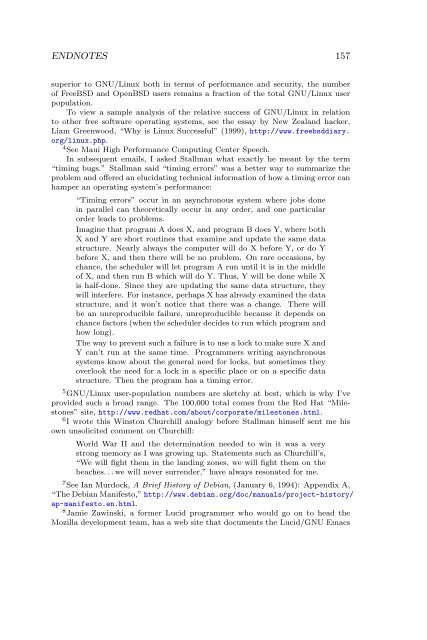You also want an ePaper? Increase the reach of your titles
YUMPU automatically turns print PDFs into web optimized ePapers that Google loves.
ENDNOTES 157<br />
superior to GNU/Linux both in terms of performance and security, the number<br />
of FreeBSD and OpenBSD users remains a fraction of the total GNU/Linux user<br />
population.<br />
To view a sample analysis of the relative success of GNU/Linux in relation<br />
to other free software operating systems, see the essay by New Zealand hacker,<br />
Liam Greenwood, “Why is Linux Successful” (1999), http://www.freebsddiary.<br />
org/linux.php.<br />
4 See Maui High Performance Computing Center Speech.<br />
In subsequent emails, I asked Stallman what exactly he meant by the term<br />
“timing bugs.” Stallman said “timing errors” was a better way to summarize the<br />
problem and offered an elucidating technical information of how a timing error can<br />
hamper an operating system’s performance:<br />
“Timing errors” occur in an asynchronous system where jobs done<br />
in parallel can theoretically occur in any order, and one particular<br />
order leads to problems.<br />
Imagine that program A does X, and program B does Y, where both<br />
X and Y are short routines that examine and update the same data<br />
structure. Nearly always the computer will do X before Y, or do Y<br />
before X, and then there will be no problem. On rare occasions, by<br />
chance, the scheduler will let program A run until it is in the middle<br />
of X, and then run B which will do Y. Thus, Y will be done while X<br />
is half-done. Since they are updating the same data structure, they<br />
will interfere. For instance, perhaps X has already examined the data<br />
structure, and it won’t notice that there was a change. There will<br />
be an unreproducible failure, unreproducible because it depends on<br />
chance factors (when the scheduler decides to run which program and<br />
how long).<br />
The way to prevent such a failure is to use a lock to make sure X and<br />
Y can’t run at the same time. Programmers writing asynchronous<br />
systems know about the general need for locks, but sometimes they<br />
overlook the need for a lock in a specific place or on a specific data<br />
structure. Then the program has a timing error.<br />
5 GNU/Linux user-population numbers are sketchy at best, which is why I’ve<br />
provided such a broad range. The 100,000 total comes from the Red Hat “Milestones”<br />
site, http://www.redhat.com/about/corporate/milestones.html.<br />
6 I wrote this Winston Churchill analogy before Stallman himself sent me his<br />
own unsolicited comment on Churchill:<br />
World War II and the determination needed to win it was a very<br />
strong memory as I was growing up. Statements such as Churchill’s,<br />
“We will fight them in the landing zones, we will fight them on the<br />
beaches. . . we will never surrender,” have always resonated for me.<br />
7 See Ian Murdock, A Brief History of Debian, (January 6, 1994): Appendix A,<br />
“The Debian Manifesto,” http://www.debian.org/doc/manuals/project-history/<br />
ap-manifesto.en.html.<br />
8 Jamie Zawinski, a former Lucid programmer who would go on to head the<br />
Mozilla development team, has a web site that documents the Lucid/GNU Emacs


